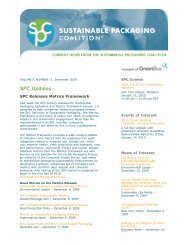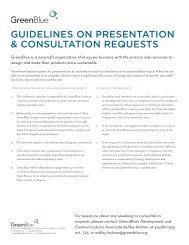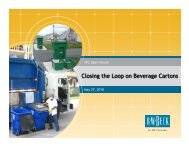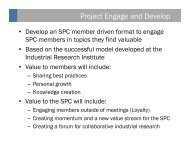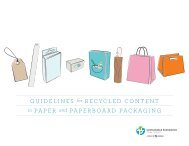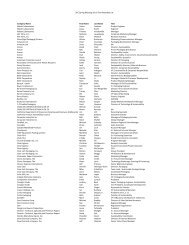Human and Environmental Health Issues of Food Packaging ...
Human and Environmental Health Issues of Food Packaging ...
Human and Environmental Health Issues of Food Packaging ...
- No tags were found...
Create successful ePaper yourself
Turn your PDF publications into a flip-book with our unique Google optimized e-Paper software.
P a r t n e r I n g f o r p e r f e c t p a c k a g I n g s o l u t I o n s<strong>Human</strong> <strong>and</strong> <strong>Environmental</strong> <strong>Health</strong> <strong>Issues</strong> <strong>of</strong> <strong>Food</strong><strong>Packaging</strong>Jane Muncke, PhD
Definition <strong>of</strong> Sustainable <strong>Packaging</strong>Sustainable <strong>Packaging</strong>:• Is beneficial, safe & healthy for individuals <strong>and</strong> communitiesthroughout its life cycle;• Meets market criteria for performance <strong>and</strong> cost;• Is sourced, manufactured, transported, <strong>and</strong> recycled using renewableenergy;• Maximizes the use <strong>of</strong> renewable or recycled source materials;• Is manufactured using clean production technologies <strong>and</strong> bestpractices;• Is made from materials healthy in all probable end-<strong>of</strong>-life scenarios;• Is physically designed to optimize materials <strong>and</strong> energy;• Is effectively recovered <strong>and</strong> utilized in biological <strong>and</strong>/or industrialcradle to cradle cycles.(No ranking implied by the order <strong>of</strong> criteria)source: http://www.sustainablepackaging.org/pdf/Definition%20<strong>of</strong>%20Sustainable%20<strong>Packaging</strong>%2010-15-05%20final.pdf22 October 2009 2
Ideal <strong>Food</strong> <strong>Packaging</strong> Fulfills High Dem<strong>and</strong>s...• protects food from outside influences• protects food from damage• provides information to consumers• is convenient• permitts product traceability• allows product marketing• is tamper-pro<strong>of</strong>• does not affect the food‘s quality• is healthy• can be produced with minimal environmentalimpact (chemical pollution, energy, emissions)photo: J. Muncke• ...?22 October 2009 3
economical/industrial• low cost• good h<strong>and</strong>ling• availability, marketing•...• healthy• user-friendly design• product information•...societalecological• non-toxic chemicals• recyclable• low emissions•...idealpackaging22 October 2009 4
<strong>Health</strong> Risk <strong>of</strong> <strong>Food</strong> <strong>Packaging</strong> ChemicalsRisk = Exposure · Effect22 October 2009 6
<strong>Health</strong> Risk <strong>of</strong> <strong>Food</strong> <strong>Packaging</strong> ChemicalsRisk = Exposure · EffectMigrationConsumption22 October 2009 7
Migration from <strong>Food</strong> <strong>Packaging</strong> into <strong>Food</strong> Depends on• Chemistry <strong>of</strong> food AND packaging:–pH– Fat content– Wetness/dryness– Organic carbon content•Temperature• <strong>Packaging</strong> size• Storage time22 October 2009 8
photo: J. Muncke 22 October 2009 9
<strong>Health</strong> Risk <strong>of</strong> <strong>Food</strong> <strong>Packaging</strong> ChemicalsRisk = Exposure · EffectMigrationConsumptionToxicity:short-termlong-term22 October 2009 10
photo: J. Muncke 22 October 2009 11
Paracelsus‘ ToxicologyParacelsus (1538): „The Third Defense“22 October 2009 12
Paracelsus‘ Toxicology Paradigm„What is there that is no poison? Allthings are poison <strong>and</strong> nothing (is)without poison. Solely, the dosedetermines that a thing is not apoison.“Paracelsus (1538: „The Third Defense“; translated from Old German in: Deichmann et al.(1986) Archives <strong>of</strong> Toxicology. 58: 207-213) photo: flickr.com22 October 2009 13
Chronic Diseases: Old vs.New Paradigmold:GENES cause DISEASEnew:GENES are influenced by ENVIRONMENTAL factors to cause DISEASE– Low-doses matter– Mixtures matter– Early development is particularly sensitive toenvironmental factors (timing matters)– Epigenetic changes affect diseasephoto: flickr.com22 October 2009 14
<strong>Environmental</strong> Hormones• Mimic biological effects <strong>of</strong> natural hormones• Also called Endocrine-Disrupting Chemicals• „Xeno“ estrogens largest group: mimic estrogen• As important a threat to humanity as climate change• Most prominent exponent: Bisphenol A22 October 2009 15
BPA• bisphenol A• high production volume chemical• 1938: found to be estrogenic in vivophoto: flickr.com• 1953: polymerization with phosgene into polycarbonate (PC)• since 1958 industrial production <strong>and</strong> use• 2006: global production > 4Mio t (estimated)•use:– Polycarbonate Plastics 65-70%• CDs, DVDs; electronics, household appliances; baby bottles– Epoxy Resins 25-30%• Coatings, adhesives, electrical laminates, food+beverage can linings, metalclosures coatings– Other Uses 5%• Thermal paper, PVC+rubber additive, precursor for other chemicals, dentalsealantsFriends <strong>of</strong> the Earth Europe (2008); Horn <strong>and</strong> Schnieders (2008) Kunstst<strong>of</strong>fe 10; Dodds <strong>and</strong> Lawson (1938) Proc. Royal Soc. London B, 125, 222-232.22 October 2009 16
<strong>Human</strong> Exposure to BPA• Carwile study 2009: 77 Harvard students– 1 week „washout“: no PC water bottles used fordrinking water– 1 week „intervention“: only PC water bottles used fordrinking waterRESULTS:Increase in BPA urinary concentration by67% during interventionUrinary level did not decrease below limit<strong>of</strong> detection during „washout“ weekCarwile et al. (2009) Env <strong>Health</strong> Perspectives 117 (9):1368-1372photo: flickr.com22 October 2009 17
Toxicity <strong>of</strong> BPA: Recent Studies• female, ovariectomized monkey• 50 µg BPA/kg body weight/d• 1 monthphoto: flickr.comreduced connections betweensynapses (nerve endings)same in Alzheimmer‘s,schizophrenia, mood disorderseffect at current FDI tolerabledaily intake (TDI) level for life timeexposurelimitations: dosing controlled byinternal pump, not dosed via foodgraph: Leranth et al. (2008) PNAS 105(37);22 October 2009 18
• 93% <strong>of</strong> USpopulation hasdetectable BPA• diabetes in ~8% <strong>of</strong>US population• no causalityLang et al.(2008) JAMA 300 (11); Diabetes http://diabetes.niddk.nih.gov/dm/pubs/statistics/22 October 2009 19
BPA induces insulin in vivo at same low doselike estradiolsingle dose 10μg/kg bwhuman TDI 50 μg/kg bw/deffect at 20% <strong>of</strong> TDI chronic exposure canlead to insulin resistanceCirculating plasma insulin in fasted (12 hr) animals 30 min after the injection <strong>of</strong> vehicle, 10 µg/kg E2 or 10 μg/kg BPA(n = 8–16); *p = 0.024, <strong>and</strong> **p = 0.004 compared with vehicle. Error bars indicate SE.Alonso-Magdalena P. et al. (2006) EHP 114(1):106-1222 October 2009 20
Insulin resistance is at the beginning <strong>of</strong> manychronic diseases that are increasingBiddinger <strong>and</strong> Khan (2006) Annu. Rev. Physiol. 68:123-15822 October 2009 21
Does BPA cause obesity?• human fatty tissue (breast)• exposed to Estradiol (E2) orBPA effect at 1/100 below averagebody burdenHugo et al. (2008) Environ <strong>Health</strong> Perspectives 116:1642-164722 October 2009 22
Mixture Toxicity: „Something from Nothing“„Estrogenicity“Concentrations <strong>of</strong> testedchemicals are at individualNOEC (no observed effectconcentrations)Silva, E. et al. (2002) Env Sci Technol 36(8):1751-1756.22 October 2009 23
Developmental Origins <strong>of</strong> Adult Disease Hypothesis• maternal nutrition <strong>and</strong> exposure to chemicals influences fetaldevelopment (heart, brain)• environmental hormones can „reprogram“ how fat is stored, the immunesystem works, etc.• fetal exposure to environmental hormones can lead to diseases thatmanifest themselves in adult life August 2008: first prospective study how fetalchemical exposure affects childhood obesityBarker, DJ (2004) J Am Coll Nutr 23(6 Suppl):588S-595SMarkman S et al. (2008) PLoS ONE 3(2):e1674Newbold RR et al. (2007) Reprod Toxicol 23(3):290-296Newbold RR et al. (2007) Reprod Toxicol 24(2):253-258Roman GC (2007) J Neurol Sci 262(1-2):15-26Smink AN (2008) Acta Pediatrica 97(10):1465-9Rubin <strong>and</strong> Soto (2009) Mol Cell Endocrinol 304: 55-62.Midori-Horiuti et al (2009) Env <strong>Health</strong> Sci in pressphoto: R. Newbold22 October 2009 24
<strong>Human</strong> Exposure to Chemicals <strong>and</strong> Increasing ChronicDiseases:HUMANEXPOSURE:to?allergiestype 2diabetesEPIDEMIOLOGY:increase <strong>of</strong>obesityneurodevelopmentaldiseaseshormonemediatedcancerstesticulardysgenesissyndrometestis♂infertilitybisphenol A......phthalatesDiOPDBP DiNPDEHPnonylphenolPFOAPFOSADHDautismbreastIs there a link?22 October 2009 25
The Future <strong>of</strong> <strong>Food</strong> <strong>Packaging</strong> Chemical Safety• Chemical contamination <strong>of</strong> food will continue to be an area <strong>of</strong>concern for regulators, industry <strong>and</strong> consumers• Improvements in chemical analysis will enhance chemicaldetection• More chemical contamination events likely due to increasingnumber <strong>and</strong> volume <strong>of</strong> imported chemicals used• New materials utilizing nanotechnologies are being developedbut toxicological effects need more evaluationJackson (2009). Journal <strong>of</strong> Agricultural <strong>and</strong> <strong>Food</strong> Chemistry. 57; 8161-8170photo: flickr.com22 October 2009 26
The Endocrine Society 2009:“The evidence for adverse reproductive outcomes (infertility,cancers, malformations) from exposure to endocrine disruptingchemicals is strong, <strong>and</strong> there is mounting evidence for effectson other endocrine systems, including thyroid, neuroendocrine,obesity <strong>and</strong> metabolism, <strong>and</strong> insulin <strong>and</strong> glucose homeostasis.”“The Precautionary Principle is key to enhancing endocrine <strong>and</strong>reproductive health, <strong>and</strong> should be used to inform decisionsabout exposure to, <strong>and</strong> risk from, potential endocrinedisruptors.”Diamanti-K<strong>and</strong>arakis et al. (2009) Endocrine Disrupting Chemicals. The Endocrine Society. http://www.endo-society.org/journals/scientificstatements/22 October 2009 27
<strong>Environmental</strong> <strong>Health</strong> <strong>Issues</strong>• High density <strong>of</strong> plastic in North PacificCentral Gyre• <strong>Environmental</strong> pollutant enrichment• Transfer <strong>of</strong> plastic-sorbed persistentenvironmental pollutants to organismsMoore C et al. (2001) Mar Pollut Bull 42(12):1297-1300Mato Y et al. (2001) Env Sci Technol 35(2):318-324www.algalita.orgTeuten EL et al. (2007) Env Sci Technol 41(22):7759-77642822 October 2009 28
Further Reading• „Our Stolen Future“ Colborn, Dumanoski, Myers 1996www.ourstolenfuture.org• „Slow Death by Rubber Duck“ Smith, Lourie 2008www.slowdeathbyrubberduck.com• Anastas <strong>and</strong> Zimmermann (2003) „Design through the 12 principles <strong>of</strong> greenengineering“ <strong>Environmental</strong> Science & Technology. 37:94A-101A.• Myers et al. (2009) „A clash <strong>of</strong> old <strong>and</strong> new scientific concepts in toxicity, withimportant implications for public health.“ <strong>Environmental</strong> <strong>Health</strong> Perspectives inpress http://ehp.niehs.nih.gov/docs/2009/0900887/abstract.html• Muncke (2009) „Exposure to endocrine disrupting compounds via the foodchain: Is packaging a relevant source?” Science <strong>of</strong> the Total Environment.407:4549-4559.• www.choosingourfuture.org• www.chemicalshealthmonitor.org• www.contaminatedwithoutconsent.org• www.endocrinedisruption.com22 October 2009 29



